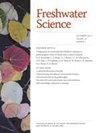Larval taxonomy of eastern Nearctic Polycentropus sensu stricto (Trichoptera: Polycentropodidae)
IF 1.6
4区 环境科学与生态学
Q3 ECOLOGY
引用次数: 1
Abstract
Although the alpha taxonomy of male caddisflies (Trichoptera) is largely well resolved in North America north of Mexico, significant work is needed to improve knowledge of larval stages. The genus Polycentropus Curtis, 1835 (Polycentropodidae) typifies this fact, with larval descriptions available for only 5/29 Nearctic species. The speciose eastern Nearctic fauna represents 22/29 Nearctic species and exemplifies a larger gap in larval taxonomy, with larval descriptions available for only 1/22 eastern Nearctic species. The inability to identify these larvae to species level precludes studies on these organisms’ biology and their inclusion in water-quality bioassessment protocols. Based on molecularly identified larvae, we describe the late- or final-instar larvae of an additional 11/22 eastern species and redescribe the larvae of Polycentropus centralis Banks, 1914. Species for which larvae are newly described are Polycentropus alabamensis Hamilton, Harris, and Lago, 1990; Polycentropus blicklei Ross and Yamamoto, 1965; Polycentropus carlsoni Morse, 1971; Polycentropus carolinensis Banks, 1905; Polycentropus confusus Hagen, 1861; Polycentropus elarus Ross, 1944; Polycentropus floridensis Lago and Harris, 1983; Polycentropus maculatus Banks, 1908; and Polycentropus pentus Ross, 1941 of the Polycentropus confusus Species Group as well as Polycentropus colei Ross, 1941 and Polycentropus rickeri Yamamoto, 1966 of the Polycentropus colei Species Group. A diagnostic matrix to assist in their identification is provided, and 1 new state record is reported. Future efforts should focus on associating and describing remaining unknown larvae and building upon the data and diagnostic tools provided herein.新北极东部窄感多心蜈蚣幼虫分类(毛翅目:多心蜈蚣科)
尽管在北美墨西哥北部的雄性毛翅虫(Trichoptera)的阿尔法分类已经得到了很好的解决,但还需要进行大量的工作来提高对幼虫阶段的认识。1835年的Polycentropus Curtis属(Polycentropodidae)代表了这一事实,只有5/29的新北极物种有幼虫描述。新北极东部物种区系占22/29个新北极物种,在幼虫分类上存在较大差距,只有1/22的新北极东部物种有幼虫描述。由于无法在物种水平上识别这些幼虫,因此无法对这些生物的生物学进行研究,也无法将它们纳入水质生物评估方案。基于分子鉴定的幼虫,我们描述了另外11/22个东部物种的晚期或终末幼虫,并重新描述了Polycentropus centralis Banks, 1914的幼虫。新发现的幼虫种有:Polycentropus alabamensis Hamilton, Harris, and Lago, 1990;罗斯和山本,1965;Polycentropus carlsoni Morse, 1971;卡罗林多棱藓,1905;Polycentropus confusus Hagen, 1861;elarus Ross, 1944;flidensis Polycentropus Lago and Harris, 1983;Polycentropus maculatus Banks, 1908;和1941年的多心猴(Polycentropus pentus Ross),以及1941年的多心猴(Polycentropus colei Ross)和1966年的多心猴(Polycentropus rickeri Yamamoto)。提供了一个诊断矩阵来帮助他们的识别,并报告了1个新的状态记录。未来的工作应该集中在联系和描述剩余的未知幼虫,并建立在这里提供的数据和诊断工具。
本文章由计算机程序翻译,如有差异,请以英文原文为准。
求助全文
约1分钟内获得全文
求助全文
来源期刊

Freshwater Science
ECOLOGY-MARINE & FRESHWATER BIOLOGY
CiteScore
4.10
自引率
0.00%
发文量
49
审稿时长
6-12 weeks
期刊介绍:
Freshwater Science (FWS) publishes articles that advance understanding and environmental stewardship of all types of inland aquatic ecosystems (lakes, rivers, streams, reservoirs, subterranean, and estuaries) and ecosystems at the interface between aquatic and terrestrial habitats (wetlands, riparian areas, and floodplains). The journal regularly features papers on a wide range of topics, including physical, chemical, and biological properties of lentic and lotic habitats; ecosystem processes; structure and dynamics of populations, communities, and ecosystems; ecology, systematics, and genetics of freshwater organisms, from bacteria to vertebrates; linkages between freshwater and other ecosystems and between freshwater ecology and other aquatic sciences; bioassessment, conservation, and restoration; environmental management; and new or novel methods for basic or applied research.
 求助内容:
求助内容: 应助结果提醒方式:
应助结果提醒方式:


